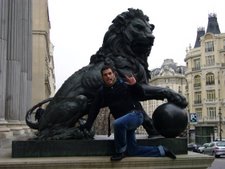But what does it represent? Let just step back a "few" years:
Back in the 12th century, the then-duke of the area had instituted a “tradition” in which he was to be allowed to spend one night with each newly married woman in his domain. Clearly, some people just went along with this out of fear of
 reprisal, but legend says that one young woman called Violetta wasn’t about to sleep with the duke - and instead of just refusing him, she chopped off his head. Her act sparked a revolution in the town of the downtrodden against their oppressive rulers, and to this day she is remembered and revered as a symbol of freedom.
reprisal, but legend says that one young woman called Violetta wasn’t about to sleep with the duke - and instead of just refusing him, she chopped off his head. Her act sparked a revolution in the town of the downtrodden against their oppressive rulers, and to this day she is remembered and revered as a symbol of freedom.Fast-forward to the early 1800s, when the traditional carnival activities that each city district celebrated separately were combined into one city-wide celebration under Napoleon, who ruled the region at the time. After the area was returned to Italian rule, the Carnevale d’Ivrea continued as one big festival in the city, including all of the various districts at once. The townsfolk dressed up in period costume, as they still do today, and reenacted specific elements from the 12th century revolt.
Perhaps not surprisingly, the Battle of the Oranges is actually a relatively recent addition to the Carnevale d’Ivrea celebrations. The orange itself is meant to symbolize the decapitated duke’s head after Violetta lobbed it off, and apparently they used beans and apples before switching to oranges at some point in the early 20th century (the exact timeline of things is more than a little unclear). What is clear is that the townsfolk are divided into nine orange-throwing teams on foot and a few more teams which are above the crowd in carriages. The teams in the carriages, who all wear enormous helmets in addition to other protective gear, are meant to represent the army of the oppressive feudal overlords, while the participants on the ground are the ordinary citizens who are trying to rebel. The folks on the ground wear some protective gear, but no helmets. Everyone involved is in costume. I swear that an orange is really painful, I got one on my head. However the most impressive was a guy in a carriages crying of pain, that was whou!




Cap comentari:
Publica un comentari a l'entrada